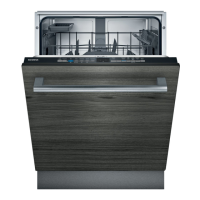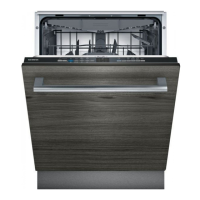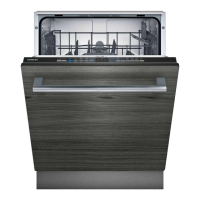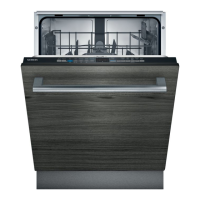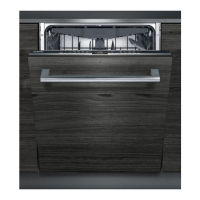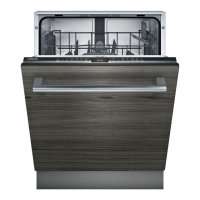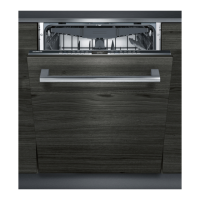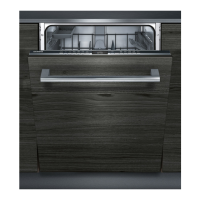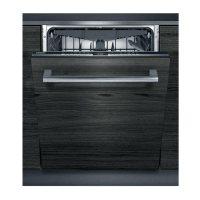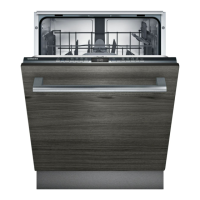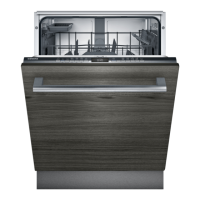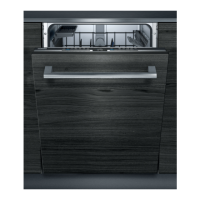Do you have a question about the Siemens SE61HX02AG and is the answer not in the manual?
Read manual, keep it safe, use appliance for household tableware in domestic environment.
Appliance for supervised use by children/reduced abilities. Improper installation is dangerous.
Dangerous installation. Connect to grounded socket. Never use external switching devices or damaged cables.
Do not use extension cords or non-approved adapters. Contact service if power cord is too short.
Hinges can cause injury. Appliance can tip if improperly installed. Ensure secure installation under worktop.
Detergent/rinse aid misuse can cause harm. Solvents or caustic agents may cause explosions.
Open door carefully to avoid injury from door or hot water. Do not sit/stand on open door.
Ingress of moisture causes shock. Never operate a damaged appliance or cord. Check power cord for damage.
Children can suffocate on packaging or small parts. They can lock themselves in. Keep children away.
Children can be crushed between doors. Detergent/rinse aid can cause chemical burns. Keep children away.
Children may injure fingers in tablet collecting tray slots. Keep children away from open appliance.
Avoid installing under hob or near heat sources. Follow installation guides for safety.
Never kink/damage hoses. Use supplied hoses. Ensure water pressure is 0.5-10 bar.
Allow cooling before opening door. Avoid steam cleaners and abrasive agents. Use special salt for dispensers.
Recycle packaging. Use Eco 50° or Half Load for energy/water saving. AquaSensor optimizes water use.
Check delivery for completeness and damage. Contact dealer/service for complaints. Note factory test marks.
Position appliance, secure if free-standing. Follow safety instructions and level appliance.
Connect to drainage system and drinking water. Ensure hoses are not kinked or obstructed.
Connect to 220-240V, 50/60Hz AC. Ensure plug is accessible and properly inserted.
Overview of parts and components. Rating plate with E-Nr. and FD-Nr. is inside the door.
Identifies key components like detergent dispenser, spray arms, filter system, cutlery basket.
Details buttons for configuring functions, selecting programmes, and checking operating status.
Explains functions of ON/OFF, Programme, Programmes, Water supply, Timer, Setup, Start, Door opener buttons.
Overview of programmes: Intensive, Auto, Eco. Details tableware type and soiling level for each.
Details Speed, Machine Care, Half Load, IntensiveZone functions. Explains runtime, consumption, and usage.
Provides conditions for comparability tests (EN60436). Requires product number (E-Nr.) and production number (FD).
How to adjust top basket height using side levers for different tableware sizes. Includes knife shelf use.
Guides on arranging pans/plates in bottom basket and cutlery in the cutlery basket.
Utilizing the cutlery shelf and space below for small cups, glasses, or large cutlery items.
Instructions for folding prongs for secure tableware placement and using the knife shelf.
Table detailing top and bottom basket height settings based on appliance height.
Steps for initial setup: add salt, rinse aid, detergent, set water hardness, run empty programme.
Explains importance of softening hard water to prevent limescale. Guides on water hardness settings and values.
Determine water hardness and set via appliance settings using Setup/Start buttons. Factory setting is level 1.
Use special salt to soften water. Add to dispenser when indicator lights up. Fill with water first on initial start-up.
Option to disable system if salt indicator is bothersome or water hardness is low (0-8 °E).
Explains the regeneration process, its impact on runtime/consumption, and provides an overview of values.
Rinse aid improves drying. Add to dispenser up to max mark. Remove spills to prevent frothing.
Change dosage if water marks appear. Set via appliance settings (0-3 LEDs). Factory setting is level 2.
Use dishwasher-safe detergents (separate/combined). Recommended to use special salt and rinse aid.
Turn off rinse aid system if indicator is irritating, e.g., with combined detergents.
Avoid hand washing liquid and chlorine detergents. They can cause frothing, damage, or health risks.
Follow instructions. Organic detergents may have reduced effect. Set system for detergent type.
Open dispenser, add detergent (tablets horizontally), close lid. Dispenser opens automatically during cycle.
Clean only dishwasher-safe items. Decorated glassware may fade or discolour. Delicate glass may turn cloudy.
Avoid damage by not washing non-dishwasher-safe items like wood, decorated glass, or copper.
Arrange tableware for better results and to prevent damage. Load efficiently to save energy and water.
WARNING: Hot tableware can cause burns. Let it cool before unloading. Unload from bottom upwards.
Open door, press ON/OFF. Eco 50° is default. Appliance auto-switches off after 10 mins inactivity.
Select programmes via button. Set additional functions based on programme. Functions depend on appliance configuration.
Delay start by 3, 6, or 9 hours. Press Start button to begin the selected programme.
Press ON/OFF to pause programme. Saved state allows resumption. Open door carefully after heating.
To cancel, open door, press Reset 4 sec., close door. Programme cancels and pumps out water.
Press ON/OFF button. Running programme is interrupted. Appliance resumes automatically on restart.
Configure water hardness, rinse aid, Extra Dry, tone volume, and factory settings as needed.
Enable/disable Extra Dry for improved drying. Increases final rinse temp, potentially runtime. Use with care for delicate items.
Set tone volume and reset appliance to factory defaults. Initial start-up settings must be reconfigured.
Clean tub with detergent at high temp, no tableware. Use only suitable cleaning products.
Wipe seals/panel with damp cloth/detergent. Leave door ajar when unused to prevent odours.
Run Machine Care periodically to prevent malfunctions from deposits. Use approved machine care products.
Follow indicator prompts or recommendations (every 2 months). Ensure correct placement of cleaning agents.
Removes soiling. Check filters after each wash. Clean micro, fine, and coarse filters under running water.
Unscrew spray arms to remove. Check nozzles for blockages under running water. Reassemble firmly.
Rectify minor faults yourself. Read info before contacting service. Repairs require trained staff.
Covers faults like kinked hoses, closed taps, or blocked filters. Provides step-by-step solutions.
Addresses wastewater hose blockages, siphon issues, loose pump covers, and technical faults. Includes 'Check water supply' flashing.
Troubleshoots appliance not closing properly and tableware not drying (rinse aid issues).
Addresses programmes without drying, water in recesses, poor detergent performance, and plasticware drying.
Deals with cutlery not drying properly due to arrangement. Recommends individual arrangement and avoiding contact points.
Explains condensation drying. Addresses food remnants, blocked spray arms/filters, and selecting appropriate programmes.
Covers inadequate rinsing of tall receptacles and uneven top basket heights. Provides positioning advice.
Addresses dispenser lid blocked by tableware or tabs. Suggests alternative programmes or detergent types.
Explains water marks on plastic and surface coatings. Recommends rinse aid, higher water softening, and mechanical cleaning.
Addresses white coatings from detergent or low temperatures. Recommends changing detergent or programme.
Covers films from vegetables or tap water. Recommends cleaning and checking water softening system.
Addresses colour deposits from food/water. Explains plastic discolouration. Recommends checking settings.
Troubleshoots removable streaks due to rinse aid levels or improper loading. Recommends adjusting rinse aid or arrangement.
Addresses irreversible clouding of glassware and rust spots on cutlery. Recommends dishwasher-proof glasses and rust-resistant cutlery.
Covers detergent residue in dispenser and excessive foam. Suggests checking spray arms, dry dispenser, and detergent brand.
Explains salt/rinse aid refill indicators. Provides troubleshooting for missing indicators or system shut-off.
Addresses water left after programme, appliance not starting, or functions failing. Involves filter cleaning and power checks.
Troubleshoots appliance not starting, automatic start, programme interruption, and door closure problems.
Covers door closure issues, dispenser lid problems, and noises from filling valves or spray arms.
Addresses noises from water jets hitting the tub or light items moving. Recommends even distribution and secure loading.
Guides on clearing blockages in the pump. Involves removing filters, water, and pump cover to access impeller.
Instructions for preparing appliance for transport/storage and for environmentally friendly disposal of old appliances.
Empty appliance if risk of frost. Transport upright to prevent water damage. Drain appliance before transport.
Recycle valuable materials. Unplug, cut cord, and dispose responsibly. Prevent child access to redundant units.
Contact service for queries, faults, or repairs. Genuine spare parts are available from Customer Service.
Locate E-Nr., FD-Nr. on rating plate. Details AQUA-STOP guarantee conditions and liability.
Provides specifications for Weight, Voltage, Power rating, Fuse, Water pressure, Inlet rate, Water temperature, and Capacity.
Details software components licensed as free/open source. Access licence info via Home Connect app or website.
Read manual, keep it safe, use appliance for household tableware in domestic environment.
Appliance for supervised use by children/reduced abilities. Improper installation is dangerous.
Dangerous installation. Connect to grounded socket. Never use external switching devices or damaged cables.
Do not use extension cords or non-approved adapters. Contact service if power cord is too short.
Hinges can cause injury. Appliance can tip if improperly installed. Ensure secure installation under worktop.
Detergent/rinse aid misuse can cause harm. Solvents or caustic agents may cause explosions.
Open door carefully to avoid injury from door or hot water. Do not sit/stand on open door.
Ingress of moisture causes shock. Never operate a damaged appliance or cord. Check power cord for damage.
Children can suffocate on packaging or small parts. They can lock themselves in. Keep children away.
Children can be crushed between doors. Detergent/rinse aid can cause chemical burns. Keep children away.
Children may injure fingers in tablet collecting tray slots. Keep children away from open appliance.
Avoid installing under hob or near heat sources. Follow installation guides for safety.
Never kink/damage hoses. Use supplied hoses. Ensure water pressure is 0.5-10 bar.
Allow cooling before opening door. Avoid steam cleaners and abrasive agents. Use special salt for dispensers.
Recycle packaging. Use Eco 50° or Half Load for energy/water saving. AquaSensor optimizes water use.
Check delivery for completeness and damage. Contact dealer/service for complaints. Note factory test marks.
Position appliance, secure if free-standing. Follow safety instructions and level appliance.
Connect to drainage system and drinking water. Ensure hoses are not kinked or obstructed.
Connect to 220-240V, 50/60Hz AC. Ensure plug is accessible and properly inserted.
Overview of parts and components. Rating plate with E-Nr. and FD-Nr. is inside the door.
Identifies key components like detergent dispenser, spray arms, filter system, cutlery basket.
Details buttons for configuring functions, selecting programmes, and checking operating status.
Explains functions of ON/OFF, Programme, Programmes, Water supply, Timer, Setup, Start, Door opener buttons.
Overview of programmes: Intensive, Auto, Eco. Details tableware type and soiling level for each.
Details Speed, Machine Care, Half Load, IntensiveZone functions. Explains runtime, consumption, and usage.
Provides conditions for comparability tests (EN60436). Requires product number (E-Nr.) and production number (FD).
How to adjust top basket height using side levers for different tableware sizes. Includes knife shelf use.
Guides on arranging pans/plates in bottom basket and cutlery in the cutlery basket.
Utilizing the cutlery shelf and space below for small cups, glasses, or large cutlery items.
Instructions for folding prongs for secure tableware placement and using the knife shelf.
Table detailing top and bottom basket height settings based on appliance height.
Steps for initial setup: add salt, rinse aid, detergent, set water hardness, run empty programme.
Explains importance of softening hard water to prevent limescale. Guides on water hardness settings and values.
Determine water hardness and set via appliance settings using Setup/Start buttons. Factory setting is level 1.
Use special salt to soften water. Add to dispenser when indicator lights up. Fill with water first on initial start-up.
Option to disable system if salt indicator is bothersome or water hardness is low (0-8 °E).
Explains the regeneration process, its impact on runtime/consumption, and provides an overview of values.
Rinse aid improves drying. Add to dispenser up to max mark. Remove spills to prevent frothing.
Change dosage if water marks appear. Set via appliance settings (0-3 LEDs). Factory setting is level 2.
Use dishwasher-safe detergents (separate/combined). Recommended to use special salt and rinse aid.
Turn off rinse aid system if indicator is irritating, e.g., with combined detergents.
Avoid hand washing liquid and chlorine detergents. They can cause frothing, damage, or health risks.
Follow instructions. Organic detergents may have reduced effect. Set system for detergent type.
Open dispenser, add detergent (tablets horizontally), close lid. Dispenser opens automatically during cycle.
Clean only dishwasher-safe items. Decorated glassware may fade or discolour. Delicate glass may turn cloudy.
Avoid damage by not washing non-dishwasher-safe items like wood, decorated glass, or copper.
Arrange tableware for better results and to prevent damage. Load efficiently to save energy and water.
WARNING: Hot tableware can cause burns. Let it cool before unloading. Unload from bottom upwards.
Open door, press ON/OFF. Eco 50° is default. Appliance auto-switches off after 10 mins inactivity.
Select programmes via button. Set additional functions based on programme. Functions depend on appliance configuration.
Delay start by 3, 6, or 9 hours. Press Start button to begin the selected programme.
Press ON/OFF to pause programme. Saved state allows resumption. Open door carefully after heating.
To cancel, open door, press Reset 4 sec., close door. Programme cancels and pumps out water.
Press ON/OFF button. Running programme is interrupted. Appliance resumes automatically on restart.
Configure water hardness, rinse aid, Extra Dry, tone volume, and factory settings as needed.
Enable/disable Extra Dry for improved drying. Increases final rinse temp, potentially runtime. Use with care for delicate items.
Set tone volume and reset appliance to factory defaults. Initial start-up settings must be reconfigured.
Clean tub with detergent at high temp, no tableware. Use only suitable cleaning products.
Wipe seals/panel with damp cloth/detergent. Leave door ajar when unused to prevent odours.
Run Machine Care periodically to prevent malfunctions from deposits. Use approved machine care products.
Follow indicator prompts or recommendations (every 2 months). Ensure correct placement of cleaning agents.
Removes soiling. Check filters after each wash. Clean micro, fine, and coarse filters under running water.
Unscrew spray arms to remove. Check nozzles for blockages under running water. Reassemble firmly.
Rectify minor faults yourself. Read info before contacting service. Repairs require trained staff.
Covers faults like kinked hoses, closed taps, or blocked filters. Provides step-by-step solutions.
Addresses wastewater hose blockages, siphon issues, loose pump covers, and technical faults. Includes 'Check water supply' flashing.
Troubleshoots appliance not closing properly and tableware not drying (rinse aid issues).
Addresses programmes without drying, water in recesses, poor detergent performance, and plasticware drying.
Deals with cutlery not drying properly due to arrangement. Recommends individual arrangement and avoiding contact points.
Explains condensation drying. Addresses food remnants, blocked spray arms/filters, and selecting appropriate programmes.
Covers inadequate rinsing of tall receptacles and uneven top basket heights. Provides positioning advice.
Addresses dispenser lid blocked by tableware or tabs. Suggests alternative programmes or detergent types.
Explains water marks on plastic and surface coatings. Recommends rinse aid, higher water softening, and mechanical cleaning.
Addresses white coatings from detergent or low temperatures. Recommends changing detergent or programme.
Covers films from vegetables or tap water. Recommends cleaning and checking water softening system.
Addresses colour deposits from food/water. Explains plastic discolouration. Recommends checking settings.
Troubleshoots removable streaks due to rinse aid levels or improper loading. Recommends adjusting rinse aid or arrangement.
Addresses irreversible clouding of glassware and rust spots on cutlery. Recommends dishwasher-proof glasses and rust-resistant cutlery.
Covers detergent residue in dispenser and excessive foam. Suggests checking spray arms, dry dispenser, and detergent brand.
Explains salt/rinse aid refill indicators. Provides troubleshooting for missing indicators or system shut-off.
Addresses water left after programme, appliance not starting, or functions failing. Involves filter cleaning and power checks.
Troubleshoots appliance not starting, automatic start, programme interruption, and door closure problems.
Covers door closure issues, dispenser lid problems, and noises from filling valves or spray arms.
Addresses noises from water jets hitting the tub or light items moving. Recommends even distribution and secure loading.
Guides on clearing blockages in the pump. Involves removing filters, water, and pump cover to access impeller.
Instructions for preparing appliance for transport/storage and for environmentally friendly disposal of old appliances.
Empty appliance if risk of frost. Transport upright to prevent water damage. Drain appliance before transport.
Recycle valuable materials. Unplug, cut cord, and dispose responsibly. Prevent child access to redundant units.
Contact service for queries, faults, or repairs. Genuine spare parts are available from Customer Service.
Locate E-Nr., FD-Nr. on rating plate. Details AQUA-STOP guarantee conditions and liability.
Provides specifications for Weight, Voltage, Power rating, Fuse, Water pressure, Inlet rate, Water temperature, and Capacity.
Details software components licensed as free/open source. Access licence info via Home Connect app or website.
| Brand | Siemens |
|---|---|
| Model | SE61HX02AG |
| Category | Dishwasher |
| Language | English |
